Steps to fix Network Discovery not working in Windows 10
Although Network Discovery saves you from having to attach files to emails or search for old USBs, it still sometimes misbehaves without any warning.
If Network Discovery is not working in Windows 10, follow the tips TipsMake suggested below to get it working again.
1. Restart the computer
Whenever you are trying to fix a problem on a Windows computer, restarting should always be the first step. There are certain benefits from rebooting, such as clearing cache, preventing memory leaks, or fixing software bugs.
Restarting can also help with network-related problems so make sure to restart the computer quickly and see if that fixes the problem. However, if this doesn't work or the problem keeps coming back, it could be a sign of a more serious problem.
2. Run Windows Troubleshooter
If restarting your computer doesn't fix the problem, you can try using Windows 10's built-in troubleshooter. Here's how you can do it:
Step 1: Click Start , then go to Settings > Update & Security . You can access the Settings menu via the gear icon to the left of the Start menu.
Step 2: From the menu on the left, select Troubleshoot.
Step 3: Click Additional troubleshooters.
Step 4: From the Find and fix other problems section , select Network adapter.
Step 5: Click Run the troubleshooter and follow the instructions shown to fix the problem.
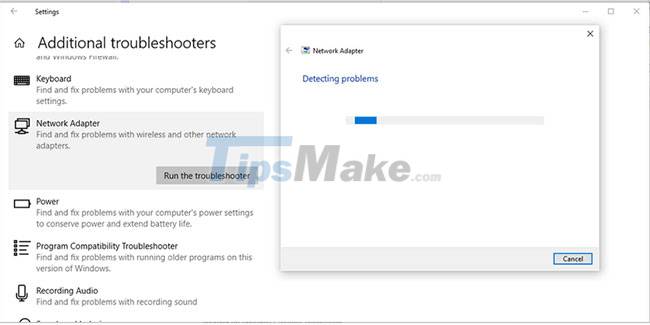
To fix this issue, you should also run the Shared Folders troubleshooter . Follow steps 1 to 3 again and in step 4, select Shared Folders.
3. Update Network Adapter driver
Network problems can be caused by outdated or damaged network adapters. Although drivers usually update automatically, you can follow the steps in the following article to ensure that your system is not running an old version: 5 basic ways to update and update drivers for your computer.
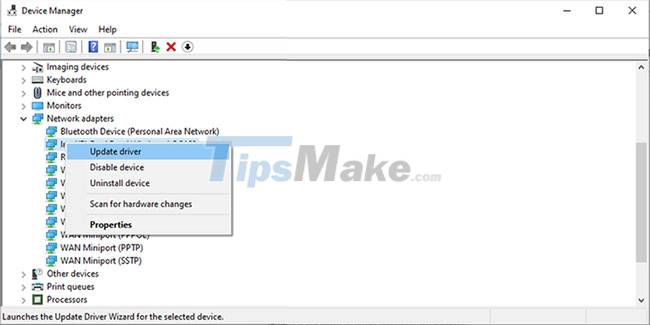
4. Check network profile
Windows 10 has two network profiles that you can choose from: Private and Public. If you've set your profile to Public , other devices won't be able to discover your computer or share files with them. Setting the profile to Public is a good idea when you're connecting to a network at coffee shops or airports to not leave your data vulnerable.
On the Private profile , Windows 10 allows the computer to share files. Basically, Windows 10 thinks it can trust private networks like the home or work network. Follow these steps to ensure that your network profile is set to Private :
Step 1: Click Start > Settings . Alternatively, you can use the keyboard shortcut Win + I .
Step 2: Select Network & Internet > Status .
Step 3: Open the Properties menu and from the Network Profile , select Private.
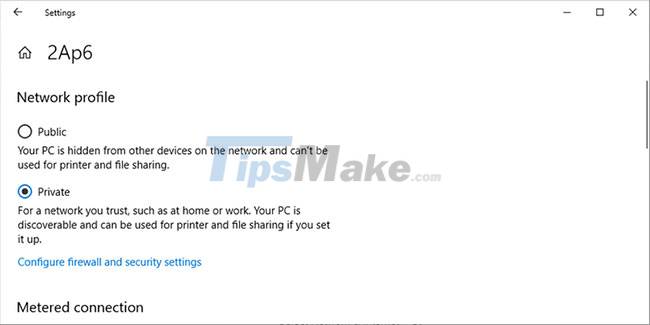
5. Check sharing options
If you've set your profile to Private and are still having issues with the Network Discovery feature, you should look into sharing options. Here's how you can do it:
Step 1: Click Start > Settings > Network & Internet .
Step 2: From Advanced network settings , select Network and Sharing Center > Change advanced sharing settings .
Step 3: Expand the Private (current profile) menu .
Step 4: From Network discovery , select the option Turn on network discovery and Turn on automatic setup of network connected devices .
Step 5: From File and printer sharing , select the option Turn on file and printer sharing .
Step 6: Click Save changes and check if the problem is now resolved.
In the Advanced sharing settings window , you should expand the Guest or Public menu and select Turn off network discovery from the Network discovery section . Also, under File and printer sharing , select Turn off file and printer sharing . This way, your computer won't be hacked when you're connected to a public network.
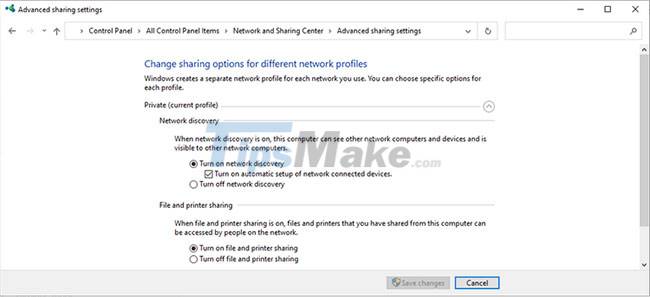
6. How to enable Network Discovery with Command Prompt
If you don't want to navigate through the Settings menu to enable the Network Discovery feature, you can use the command line. Follow these steps to enable the Network Discovery feature using Command Prompt:
Step 1: In the Start menu search bar , search for command prompt and select Run as administrator to open CMD with admin rights.
Step 2: Enter the following command:
netsh advfirewall firewall set rule group='Network Discovery' new enable=YesStep 3: Press the Enter button . This will enable the Network Discovery feature.

To disable this feature, type the following command and press Enter :
netsh advfirewall firewall set rule group='Network Discovery' new enable=No7. Use the network reset feature
If everything seems fine with the network settings, you can try resetting this setting to fix the Network Discovery issue. Reference: This is how to reset network settings on Windows 10 with just 1 click for detailed instructions.

If you are using VPN client software or any virtual switches, you will have to reinstall them after resetting the network.
8. Check the Services settings
In Windows 10, Services contain programs that run in the background that take care of system functions, such as remote access, printing, networking, etc. Normally, the system has no problem checking control background services. However, sometimes you need to step in and fix a feature or when the app stops working. Follow these steps to change the Services settings and get the Network Discovery feature working again:
Step 1: In the Start menu search bar , search for services and select Run as administrator .
Step 2: Locate DNS Client and open it.
Step 3: Select the General tab and check if the status is Running or not. If not, click Start.
Step 4: Check if the Startup type is set to Automatic .
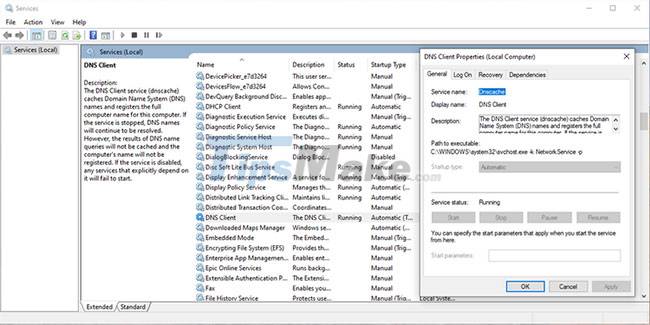
Repeat the same steps for Function Discovery Resource Publication, Function Discovery Provider Host, UPnP Device Host and SSDP Discovery .
9. Check Windows Firewall settings
The Network Discovery feature may have stopped working because Windows Firewall is blocking it. Follow these steps to check Windows Firewall settings:
Step 1: Open Control Panel.
Step 2: From the View by menu , select Large icons and Small icons.
Step 3: Click Windows Defender Firewall .
Step 4: Select Allow an app or feature through Windows Defender Firewall .
Step 5: In the Allowed apps window , click the Change Settings button . Then scroll down to Network Discovery and select Private.
Step 6: Click OK to save the changes.
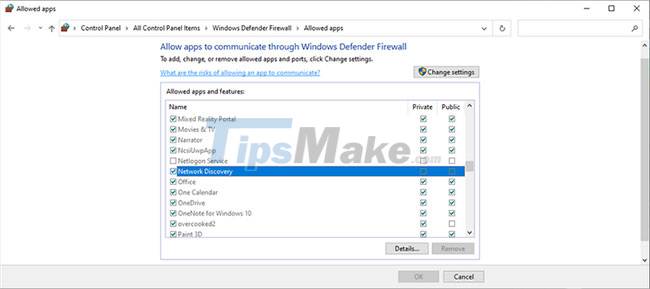
Good luck with your troubleshooting!
You should read it
- 7 best network troubleshooting tools 'save' your home network
- Network sharing settings in Windows 7
- Instructions for configuring DNS Service Discovery
- Working with Network Monitor (Part 1)
- Solve the real problem with the Network Diagnostic function
- How to fix the error that cannot access another machine in Windows 10 LAN
- VPN theory - What is a virtual private network?
- Introduction to Network Access Protection (Part 1)
May be interested
- Steps to fix keyboard not working on Windows 10
 on a beautiful day while at work, suddenly your windows 10 computer keyboard does not work properly and cannot type letters and numbers. here are 6 ways to fix windows 10 keyboard not working, not working properly, simple and effective.
on a beautiful day while at work, suddenly your windows 10 computer keyboard does not work properly and cannot type letters and numbers. here are 6 ways to fix windows 10 keyboard not working, not working properly, simple and effective. - Steps to fix 'Shell Infrastructure Host Has Stopped Working' error in Windows
 is your windows device showing 'shell infrastructure host has stopped working' error? in most cases, this problem occurs when running the application on a windows guest account.
is your windows device showing 'shell infrastructure host has stopped working' error? in most cases, this problem occurs when running the application on a windows guest account. - How to fix the error that cannot access another machine in Windows 10 LAN
 guide to check lan settings, turn off firewall, turn on network discovery and check the connection between two computers to get to the windows 10 lan.
guide to check lan settings, turn off firewall, turn on network discovery and check the connection between two computers to get to the windows 10 lan. - 4 handy networking tools built into Windows 10 PCs and their functions
 networking is an essential part of modern computing. whether you're working from home or in the office, a reliable and efficient network can make a complete difference in productivity.
networking is an essential part of modern computing. whether you're working from home or in the office, a reliable and efficient network can make a complete difference in productivity. - How to fix Windows 11 Taskbar not working
 the windows 11 taskbar provides access to frequently used applications, virtual desktops, start menu, and quick settings. if the taskbar stops working, you may have problems navigating your computer.
the windows 11 taskbar provides access to frequently used applications, virtual desktops, start menu, and quick settings. if the taskbar stops working, you may have problems navigating your computer. - Instructions for configuring DNS Service Discovery
 in essence, dns service discovery (dns-sd) is a part of zeroconf networking system - with the function of allowing servers and clients on the same network to exchange information and access data in the lan without any setting, configuration ...
in essence, dns service discovery (dns-sd) is a part of zeroconf networking system - with the function of allowing servers and clients on the same network to exchange information and access data in the lan without any setting, configuration ... - How to fix Tab key not working on Windows
 sometimes you may notice that the tab key doesn't work as expected. this can be really frustrating, especially if you rely on the tab key for everyday tasks.
sometimes you may notice that the tab key doesn't work as expected. this can be really frustrating, especially if you rely on the tab key for everyday tasks. - Steps to fix Print Screen key not working
 the print screen (prtscr) key is one of the fastest ways to take screenshots on windows. however, if the print screen key suddenly stops working, there are a few workarounds you can try.
the print screen (prtscr) key is one of the fastest ways to take screenshots on windows. however, if the print screen key suddenly stops working, there are a few workarounds you can try. - How to fix Micro not working on Windows 10
 many users are facing the microphone not working error on their computer after updating to recent versions of windows 10 and they don't know how to check and solve the problem, hence, thuthuat.taimienphi. vn has compiled ways to fix micro not working on windows 10 for you to learn and apply.
many users are facing the microphone not working error on their computer after updating to recent versions of windows 10 and they don't know how to check and solve the problem, hence, thuthuat.taimienphi. vn has compiled ways to fix micro not working on windows 10 for you to learn and apply. - Fix Alt + Tab not working in Windows 10
 in this article, we will provide the most suitable solutions that you can try to help you fix alt + tab not working error in windows 10.
in this article, we will provide the most suitable solutions that you can try to help you fix alt + tab not working error in windows 10.










 Set to automatically delete files in the Download folder on Windows 10
Set to automatically delete files in the Download folder on Windows 10 Steps to fix the error of not opening Steam on Windows 10
Steps to fix the error of not opening Steam on Windows 10 How to decrypt files and folders on Windows 10
How to decrypt files and folders on Windows 10 Steps to fix volume automatically increase/decrease in Windows 10
Steps to fix volume automatically increase/decrease in Windows 10 Steps to fix PrintNightmare vulnerability on Windows 10
Steps to fix PrintNightmare vulnerability on Windows 10 Steps to switch to 5GHz WiFi band on Windows 10
Steps to switch to 5GHz WiFi band on Windows 10